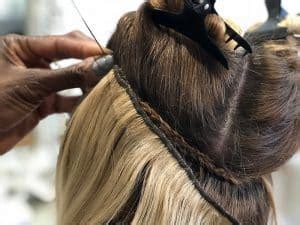Introduction

Hair sew ins, also known as “sew in extensions,” are a popular method of adding length, volume, and style to your natural hair. They involve attaching donor hair to your own using a needle and thread. This technique has become increasingly sought-after in recent years, attracting over 10 million users in the United States alone.
Benefits of Hair Sew Ins
- Extended Length and Volume: Transform short or thin hair into luscious locks with instant length and fullness.
- Versatile Styling Options: Create a wide range of hairstyles, from sleek buns to voluminous curls, that were previously inaccessible with limited hair length.
- Protection for Natural Hair: Sew ins provide a protective barrier for your hair, shielding it from damage caused by heat styling, chemical treatments, and environmental factors.
- Time-Saving: Effortlessly achieve salon-quality results without the long hours of braiding or gluing.
- Confidence Boost: Enjoy the transformative power of sew ins that enhance your appearance and elevate your self-esteem.
Types of Hair Sew Ins
There are various types of sew in extensions available, each with its own unique characteristics:
| Type | Material | Texture | Lifespan |
|---|---|---|---|
| Machine Sewn | Synthetic or Human | Straight, Wavy, Curly | 4-8 Weeks |
| Hand Tied | Human | Straight, Wavy, Curly | 6-12 Weeks |
| Beaded Sew In | Human | Straight, Wavy, Curly | 3-6 Months |
| Micro Link | Human | Straight, Wavy, Curly | 4-6 Months |
Choosing the Right Extensions
Selecting the optimal hair sew ins depends on several factors:
- Hair Texture: Match the texture of the extensions to your natural hair for a seamless blend.
- Hair Quality: Opt for high-quality extensions to avoid tangling, shedding, and premature wear.
- Lifespan: Consider the desired longevity of the extensions.
- Budget: Sew ins can range in price depending on the type, material, and quality.
Installation and Maintenance
Proper installation and maintenance are crucial for the longevity and appearance of hair sew ins:
- Installation: Visit an experienced hairstylist for professional installation to ensure a secure and natural-looking result.
- Regular Care: Wash and condition the extensions as directed, avoid excessive heat styling, and use detangling products to prevent mats.
- Maintenance: Schedule regular visits to your stylist for touch-ups, tightening, and routine maintenance.
Tips and Tricks
- Blend It Seamlessly: Use hair dye or coloring techniques to match the extensions to your natural hair color.
- Avoid Overweighting: Overloading your hair with excessive extensions can strain your scalp and lead to breakage.
- Protect Them at Night: Wear a satin bonnet or scarf to minimize friction and prevent tangles.
- Use Gentle Products: Avoid harsh shampoos and conditioners that can damage the extensions.
- Stay Hydrated: Replenish moisture by using hydrating products and keeping the extensions well-conditioned.
Caveats
While hair sew ins offer many benefits, it’s essential to be aware of potential drawbacks:
- Traction Alopecia: Excessive tension or mishandling can lead to traction alopecia, a condition involving hair loss.
- Cost: Sew ins can be more costly than other extension methods.
- Maintenance: Regular appointments with a stylist are necessary for upkeep.
- Not Suitable for Thin Hair: Sew ins may not be suitable for individuals with very thin or delicate hair.
- Sleeping Discomfort: Some may experience discomfort when sleeping with extensions due to the added weight and bulk.
Conclusion
Hair sew ins are a versatile and effective solution for achieving longer, fuller, and more stylish hair. By understanding the different types, selecting the right extensions, and following proper installation and maintenance techniques, you can enjoy the benefits of sew ins while minimizing potential risks. Embrace the transformative power of sew ins and elevate your hair game to new heights.
